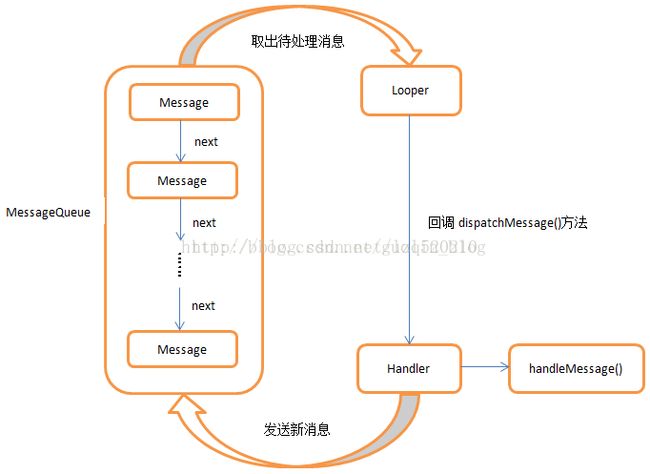Handler消息机制--面试篇
最近在准备面试题,重新温习一下android知识,今天主角是Handler。
首先,为什么要使用到Handler,众所周知,android的更新ui是在主线程中进行的,更新ui大部分是需要重后台获取数据的,而主线程中又不允许进行耗时操作,这时我们就要在子线程中进行网络请求,然后更新ui,可是子线程中又不允许操作ui,这时候我们就用到了Handler,将消息发送到主线程中,进而在主线程中更新ui。
提到Handler,自然而然就想到了与其相关的几个兄弟,Mesage、MessageQueue、Looper,下面一一介绍
1、Handler:用来发送和处理消息的
2、Message:消息对象,可以携带数据
3、MessageQueue:消息队列,用于存放消息对象的
4、Looper:用于监控MessageQueue中是否有Message对象的,如果有,就将其发送给Handler进行处理
Handler的工作流程,我想借用别人的一张图片如下:
简单介绍一下Handler发送消息的流程
在主线程中创建Handler对象,重写handleMessage方法
private Handler handler2 = new Handler() {
public void handleMessage(Message msg) {
// 主线程要做的事情
switch (msg.what) {
case 2:
//可以操作ui
break;
}
super.handleMessage(msg);
}
}; new Thread(new Runnable() {
@Override
public void run() {
Message msg = new Message();
msg.what = 2;//上传成功 发送 4
//将result resourceId传回去
Bundle bundle = new Bundle();
bundle.putInt("resourceId", resourceId);
msg.setData(bundle);
handler2.sendMessage(msg);
}
}).start(); handler = new Handler();
new Thread(new Runnable() {
@Override
public void run() {
handler.post(new Runnable() {
@Override
public void run() {
// 在这里进行UI操作
}
});
}
}).start(); 首先,在主线程、子线程中分别创建一个Handler对象
handler1 = new Handler();
new Thread(new Runnable() {
@Override
public void run() {
handler2 = new Handler();
}
}).start(); Can't create handler inside thread that has not called Looper.prepare()
new Thread(new Runnable() {
@Override
public void run() { Looper.prepare();
handler2 = new Handler();
}
}).start();
public Handler() {
if (FIND_POTENTIAL_LEAKS) {
final Class klass = getClass();
if ((klass.isAnonymousClass() || klass.isMemberClass() || klass.isLocalClass()) &&
(klass.getModifiers() & Modifier.STATIC) == 0) {
Log.w(TAG, "The following Handler class should be static or leaks might occur: " +
klass.getCanonicalName());
}
}
mLooper = Looper.myLooper();
if (mLooper == null) {
throw new RuntimeException(
"Can't create handler inside thread that has not called Looper.prepare()");
}
mQueue = mLooper.mQueue;
mCallback = null;
} mLooper = Looper.myLooper(); if (mLooper == null) {
throw new RuntimeException(
"Can't create handler inside thread that has not called Looper.prepare()");
}
public static final Looper myLooper() {
return (Looper)sThreadLocal.get();
}
public static final void prepare() {
if (sThreadLocal.get() != null) {
throw new RuntimeException("Only one Looper may be created per thread");
}
sThreadLocal.set(new Looper()); //就是这里 哈哈
}
public static void main(String[] args) {
SamplingProfilerIntegration.start();
CloseGuard.setEnabled(false);
Environment.initForCurrentUser();
EventLogger.setReporter(new EventLoggingReporter());
Process.setArgV0("");
Looper.prepareMainLooper(); //重点看这里
ActivityThread thread = new ActivityThread();
thread.attach(false);
if (sMainThreadHandler == null) {
sMainThreadHandler = thread.getHandler();
}
AsyncTask.init();
if (false) {
Looper.myLooper().setMessageLogging(new LogPrinter(Log.DEBUG, "ActivityThread"));
}
Looper.loop();
throw new RuntimeException("Main thread loop unexpectedly exited");
} public static final void prepareMainLooper() {
prepare();
setMainLooper(myLooper());
if (Process.supportsProcesses()) {
myLooper().mQueue.mQuitAllowed = false;
}
} 简单总结一下,就是主线程中可以直接创建Handler对象,而在子线程中创建Handler对象之前,要先调用Looper.prepare(),来手动创建Looper对象。
接下来我想引用郭霖大神关于Handler如何发送消息的博文来说一下,还请各位见谅,哈哈。
看完了如何创建Handler之后,接下来我们看一下如何发送消息,这个流程相信大家也已经非常熟悉了,new出一个Message对象,然后可以使用setData()方法或arg参数等方式为消息携带一些数据,再借助Handler将消息发送出去就可以了,示例代码如下:
new Thread(new Runnable() {
@Override
public void run() {
Message message = new Message();
message.arg1 = 1;
Bundle bundle = new Bundle();
bundle.putString("data", "data");
message.setData(bundle);
handler.sendMessage(message);
}
}).start();
public boolean sendMessageAtTime(Message msg, long uptimeMillis)
{
boolean sent = false;
MessageQueue queue = mQueue;
if (queue != null) {
msg.target = this;
sent = queue.enqueueMessage(msg, uptimeMillis);
}
else {
RuntimeException e = new RuntimeException(
this + " sendMessageAtTime() called with no mQueue");
Log.w("Looper", e.getMessage(), e);
}
return sent;
} sendMessageAtTime()方法接收两个参数,其中msg参数就是我们发送的Message对象,而uptimeMillis参数则表示发送消息的时间,它的值等于自系统开机到当前时间的毫秒数再加上延迟时间,如果你调用的不是sendMessageDelayed()方法,延迟时间就为0,然后将这两个参数都传递到MessageQueue的enqueueMessage()方法中。这个MessageQueue又是什么东西呢?其实从名字上就可以看出了,它是一个消息队列,用于将所有收到的消息以队列的形式进行排列,并提供入队和出队的方法。这个类是在Looper的构造函数中创建的,因此一个Looper也就对应了一个MessageQueue。
那么enqueueMessage()方法毫无疑问就是入队的方法了,我们来看下这个方法的源码:
final boolean enqueueMessage(Message msg, long when) {
if (msg.when != 0) {
throw new AndroidRuntimeException(msg + " This message is already in use.");
}
if (msg.target == null && !mQuitAllowed) {
throw new RuntimeException("Main thread not allowed to quit");
}
synchronized (this) {
if (mQuiting) {
RuntimeException e = new RuntimeException(msg.target + " sending message to a Handler on a dead thread");
Log.w("MessageQueue", e.getMessage(), e);
return false;
} else if (msg.target == null) {
mQuiting = true;
}
msg.when = when;
Message p = mMessages;
if (p == null || when == 0 || when < p.when) {
msg.next = p;
mMessages = msg;
this.notify();
} else {
Message prev = null;
while (p != null && p.when <= when) {
prev = p;
p = p.next;
}
msg.next = prev.next;
prev.next = msg;
this.notify();
}
}
return true;
} 首先你要知道,MessageQueue并没有使用一个集合把所有的消息都保存起来,它只使用了一个mMessages对象表示当前待处理的消息。然后观察上面的代码的16~31行我们就可以看出,所谓的入队其实就是将所有的消息按时间来进行排序,这个时间当然就是我们刚才介绍的uptimeMillis参数。具体的操作方法就根据时间的顺序调用msg.next,从而为每一个消息指定它的下一个消息是什么。当然如果你是通过sendMessageAtFrontOfQueue()方法来发送消息的,它也会调用enqueueMessage()来让消息入队,只不过时间为0,这时会把mMessages赋值为新入队的这条消息,然后将这条消息的next指定为刚才的mMessages,这样也就完成了添加消息到队列头部的操作。
public static final void loop() {
Looper me = myLooper();
MessageQueue queue = me.mQueue;
while (true) {
Message msg = queue.next(); // might block
if (msg != null) {
if (msg.target == null) {
return;
}
if (me.mLogging!= null) me.mLogging.println(
">>>>> Dispatching to " + msg.target + " "
+ msg.callback + ": " + msg.what
);
msg.target.dispatchMessage(msg);
if (me.mLogging!= null) me.mLogging.println(
"<<<<< Finished to " + msg.target + " "
+ msg.callback);
msg.recycle();
}
}
} public void dispatchMessage(Message msg) {
if (msg.callback != null) {
handleCallback(msg);
} else {
if (mCallback != null) {
if (mCallback.handleMessage(msg)) {
return;
}
}
handleMessage(msg);
}
}
因此,一个最标准的异步消息处理线程的写法应该是这样:
class LooperThread extends Thread {
public Handler mHandler;
public void run() {
Looper.prepare();
mHandler = new Handler() {
public void handleMessage(Message msg) {
// process incoming messages here
}
};
Looper.loop();
}
} 另外除了发送消息之外,我们还有以下几种方法可以在子线程中进行UI操作:
1. Handler的post()方法
2. View的post()方法
3. Activity的runOnUiThread()方法
我们先来看下Handler中的post()方法,代码如下所示:
public final boolean post(Runnable r)
{
return sendMessageDelayed(getPostMessage(r), 0);
} private final Message getPostMessage(Runnable r) {
Message m = Message.obtain();
m.callback = r;
return m;
}
private final void handleCallback(Message message) {
message.callback.run();
} public class MainActivity extends Activity {
private Handler handler;
@Override
protected void onCreate(Bundle savedInstanceState) {
super.onCreate(savedInstanceState);
setContentView(R.layout.activity_main);
handler = new Handler();
new Thread(new Runnable() {
@Override
public void run() {
handler.post(new Runnable() {
@Override
public void run() {
// 在这里进行UI操作
}
});
}
}).start();
}
}
然后再来看一下View中的post()方法,代码如下所示:
public boolean post(Runnable action) {
Handler handler;
if (mAttachInfo != null) {
handler = mAttachInfo.mHandler;
} else {
ViewRoot.getRunQueue().post(action);
return true;
}
return handler.post(action);
}
最后再来看一下Activity中的runOnUiThread()方法,代码如下所示:
public final void runOnUiThread(Runnable action) {
if (Thread.currentThread() != mUiThread) {
mHandler.post(action);
} else {
action.run();
}
}
